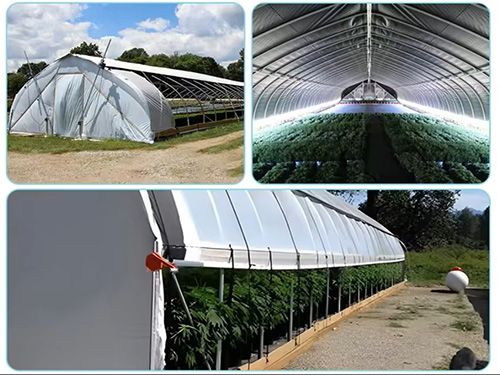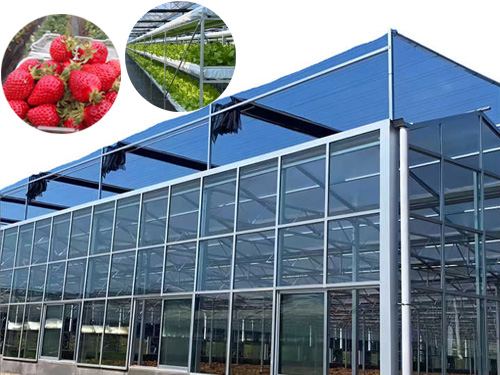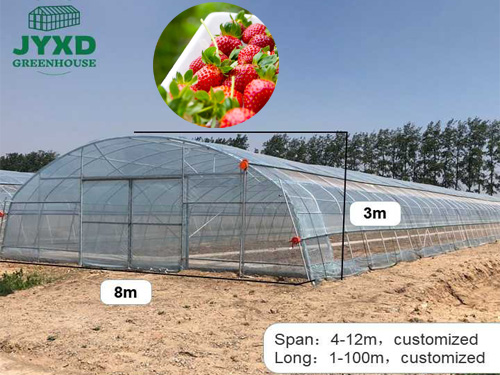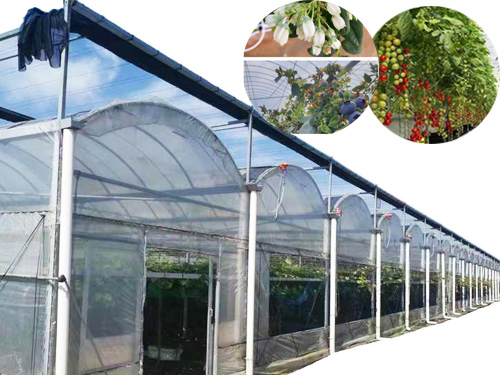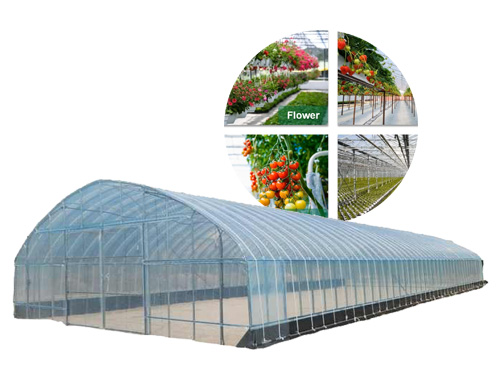NEWS DETAILS
NEWS INFORMATION
Addressing Rising Greenhouse Energy Costs: Energy-Saving and Cost-Control Solutions
AUTHOR:jyxd-greenhouse DATE:2025-01-29 05:11:31 HITS:183
As the cost of energy continues to rise globally, greenhouse growers face increasing pressure to manage their energy consumption without compromising crop production. Greenhouses are energy-intensive environments, requiring careful control of temperature, humidity, and light. However, there are several effective strategies and technologies available to help greenhouse operators reduce energy costs and improve energy efficiency. In this article, we will explore energy-saving solutions and cost-control measures that can make a significant impact on greenhouse energy consumption.
Understanding the Energy Demands of Greenhouses
Greenhouses require significant amounts of energy to maintain optimal growing conditions. The primary energy demands include:
· Heating: In cooler climates or during winter months, maintaining a stable temperature is critical for plant health. This often involves heating systems that consume substantial amounts of energy.
· Cooling: During the warmer months, cooling systems, such as fans or evaporative cooling, are necessary to prevent heat stress on plants.
· Lighting: Many greenhouse crops require supplemental lighting, especially in regions with limited daylight hours. Artificial lighting systems can contribute significantly to energy costs.
· Ventilation: Proper airflow is essential to maintain healthy plant growth and reduce humidity, requiring energy-consuming ventilation systems.
Given these significant energy requirements, it is essential to adopt energy-saving strategies to reduce overall costs.
Energy-Saving Solutions for Greenhouses
There are several practical and effective solutions to help greenhouse operators save energy and cut costs. Here are some of the most impactful strategies:
1. Investing in Energy-Efficient Heating Systems
Heating systems are one of the largest energy consumers in greenhouses, especially in colder climates. Upgrading to energy-efficient heating systems can significantly reduce energy consumption while still maintaining optimal conditions for plant growth.
· Infrared Heaters: Infrared heaters are more energy-efficient than traditional heating methods because they directly heat plants and surfaces, rather than heating the air. This allows for a more uniform distribution of warmth, reducing overall energy usage.
· Heat Pumps: Heat pumps are an excellent alternative to traditional heating systems. These devices extract heat from the outside air and transfer it into the greenhouse. They are highly energy-efficient and can also be used for cooling during warmer months.
· Thermal Screens: Installing thermal screens or blankets in greenhouses can help retain heat during colder nights. These screens prevent heat loss and reduce the need for additional heating.
By investing in energy-efficient heating systems, greenhouse operators can significantly lower their heating costs.
2. Optimizing Cooling Systems
In addition to heating, cooling systems also contribute heavily to energy consumption. Implementing energy-saving strategies for cooling can help reduce overall energy costs.
· Evaporative Cooling: This natural cooling technique uses water evaporation to reduce air temperature. It is more energy-efficient than traditional air conditioning systems, as it uses significantly less electricity.
· Shading Systems: Installing shading systems or screens can help reduce the need for cooling by blocking out excessive sunlight and preventing overheating. Shade nets or retractable screens can be used to regulate the amount of sunlight entering the greenhouse, improving temperature control.
· Night Ventilation: Using natural ventilation during the cooler nighttime hours can help lower the temperature inside the greenhouse without relying on energy-intensive cooling systems. Properly designed ventilation systems can reduce the need for mechanical cooling during the day.
By optimizing cooling techniques and systems, greenhouse operators can maintain comfortable growing conditions while saving energy.
3. Utilizing LED Lighting
Lighting is another significant source of energy consumption in greenhouses. Traditional lighting systems, such as high-pressure sodium (HPS) lights, are energy-intensive and can increase electricity costs. Switching to energy-efficient LED lighting can dramatically reduce energy usage and costs.
· Energy Efficiency: LEDs use less energy and have a longer lifespan compared to traditional lighting systems. They provide the same level of light intensity with lower energy consumption, reducing the overall energy bill.
· Tailored Light Spectrum: LEDs can be customized to emit specific light spectra that are optimal for plant growth. This means that energy is not wasted on unnecessary wavelengths, improving both energy efficiency and plant health.
· Automated Lighting Control: Installing automated lighting systems that adjust light intensity based on the time of day and plant needs can further reduce energy usage. Light levels can be optimized for different plant growth stages, ensuring that only the necessary amount of light is used.
Switching to LED lighting offers a long-term solution for reducing energy costs while ensuring optimal growing conditions.
4. Implementing Renewable Energy Sources
Incorporating renewable energy sources into greenhouse operations can help reduce reliance on conventional energy grids and lower energy costs in the long term.
· Solar Panels: Solar energy can be used to power greenhouse operations, from lighting and heating to irrigation systems. By installing solar panels on the roof of the greenhouse or in surrounding areas, operators can generate their own electricity and reduce utility bills.
· Wind Energy: In regions with consistent wind patterns, wind turbines can provide a renewable energy source to supplement electricity needs. Wind power can be particularly useful for powering ventilation systems or irrigation pumps.
· Geothermal Energy: In areas with geothermal potential, geothermal heating systems can provide an efficient and sustainable alternative to traditional heating methods. Geothermal systems use the earth's natural heat to maintain stable temperatures within the greenhouse.
By investing in renewable energy sources, greenhouse operators can not only reduce energy costs but also contribute to a more sustainable and eco-friendly farming practice.
5. Improving Insulation and Building Design
Efficient insulation and greenhouse design play a crucial role in reducing the energy required for heating and cooling. Properly insulating the greenhouse structure helps to minimize heat loss during the winter and reduce the need for cooling in the summer.
· Double Glazing: Using double-glazed glass or polycarbonate panels for greenhouse walls and roofs improves insulation and reduces heat loss. This can significantly reduce heating costs, especially in colder climates.
· Insulated Foundations: Installing insulated foundations and floors helps to prevent heat loss from the ground, improving the overall energy efficiency of the greenhouse.
· Reflective Surfaces: Using reflective materials on the interior of the greenhouse can help direct sunlight towards plants, reducing the need for supplemental lighting.
By focusing on insulation and smart building design, greenhouse operators can create a more energy-efficient environment that reduces heating and cooling costs.
Cost-Control Strategies for Greenhouses
In addition to energy-saving solutions, greenhouse operators can implement various cost-control measures to further reduce their overall operational expenses.
1. Monitoring Energy Usage with Smart Technology
Smart energy management systems can help greenhouse operators monitor and control energy usage in real-time. These systems track energy consumption patterns, detect inefficiencies, and provide recommendations for optimizing energy use.
· Energy Management Software: Software solutions can analyze data from energy meters, temperature sensors, and environmental controls to identify areas where energy consumption can be reduced.
· Automation and Control Systems: Automated systems can adjust heating, cooling, and lighting based on real-time data, optimizing energy usage without manual intervention.
By using smart technology, greenhouse operators can track energy usage more accurately and implement adjustments that lead to long-term cost savings.
2. Regular Maintenance and Equipment Upgrades
Regular maintenance of greenhouse systems is essential to keep equipment running efficiently and prevent costly breakdowns. Ensure that heating, cooling, and lighting systems are regularly inspected and maintained to avoid inefficiencies that lead to higher energy consumption.
· Upgrading Old Equipment: Replacing outdated or inefficient equipment with newer, energy-efficient models can pay off in the long run by reducing energy consumption and maintenance costs.
By prioritizing maintenance and upgrading equipment, greenhouse operators can extend the lifespan of their systems and reduce long-term costs.
Conclusion
Rising energy costs pose a significant challenge for greenhouse operators, but there are many strategies available to help mitigate these costs. By implementing energy-efficient heating and cooling systems, using LED lighting, incorporating renewable energy sources, and improving insulation, greenhouse operators can reduce their energy consumption and cut costs. Additionally, utilizing smart technology and performing regular maintenance can further optimize energy usage and improve overall cost control. With careful planning and investment, greenhouse operators can create more sustainable and cost-effective operations while maintaining healthy and productive crops.
Hebei Juyou Xinda Greenhouse Facilities Co.,Ltd.
Copyright © 2024-2025 https://www.jyxd-greenhouse.com. All Rights Reserved Hebei Juyou Xinda Greenhouse Facilities Co.,Ltd.Copyright





 Current Location:
Current Location:


